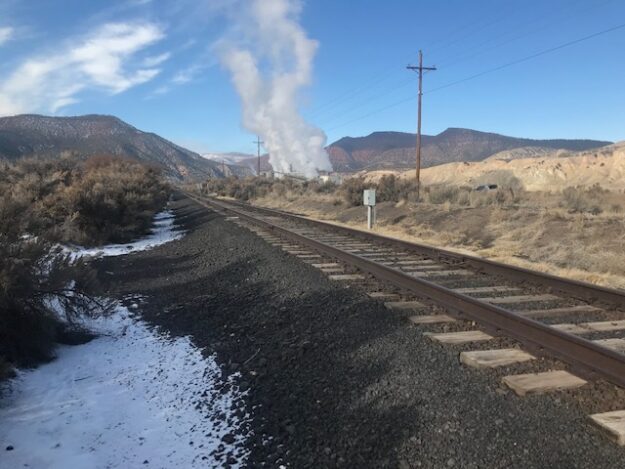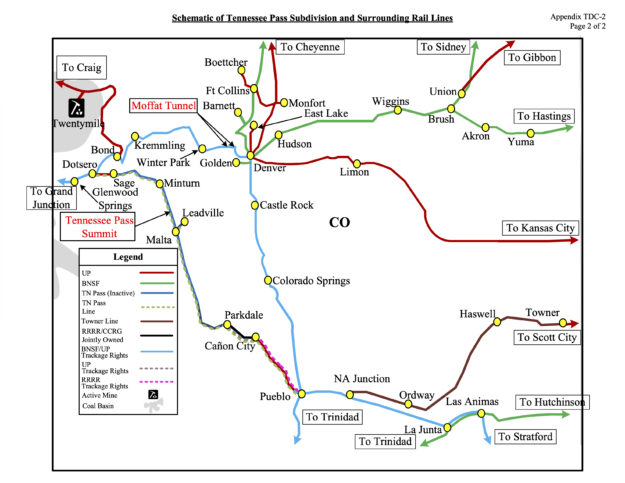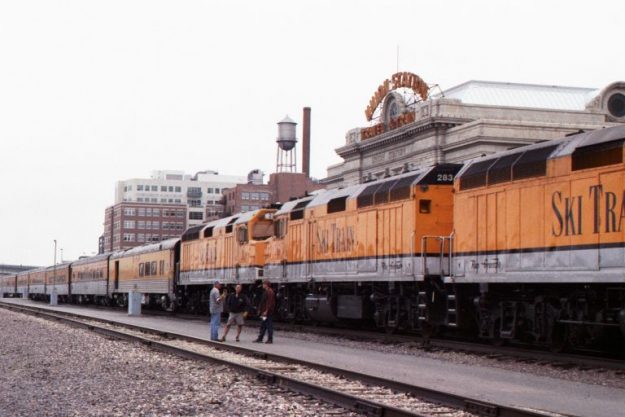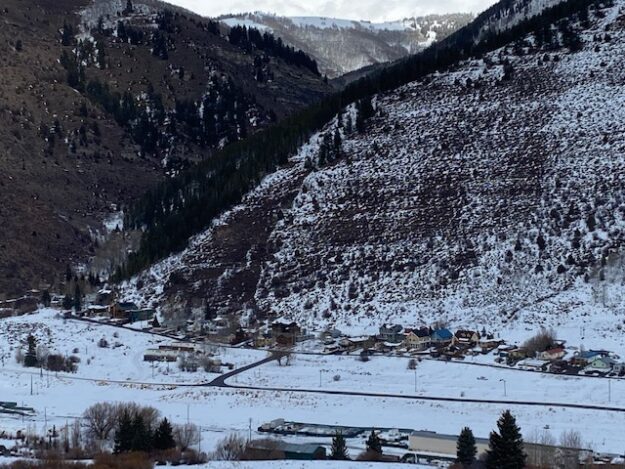Widgetized Section
Go to Admin » Appearance » Widgets » and move Gabfire Widget: Social into that MastheadOverlay zone
Is Sage to Parkdale a train to nowhere or a way for UP to hold onto Tennessee Pass?

Where the hell is Sage, Colorado? And why would a railroad company be considering starting a commuter passenger rail service there and running trains along the long-dormant Tennessee Pass Line (TPL) to a place called Parkdale? Seems like a train to nowhere, right (see map)?
But that’s the extent of the lease deal the nascent Colorado Midland & Pacific Railway struck with TPL owner Union Pacific to run passenger and freight trains over 160 miles of revamped tracks right through the heart of Eagle County. Colorado Pacific, a rival railroad company with a freight line in southeastern Colorado, has proposed passenger service from Pueblo to Minturn.

Sounds like a “cute” idea, as one stakeholder told RealVail.com, but why not connect service on through to places that actually link up to existing, active rail lines, if in fact this very expensive revamp of a quarter-century dormant line is all about passengers? The Colorado Midland proposal would not do that, nor does there seem to be big demand for Pueblo to Minturn.
Sage is really just a point on a railroad map along U.S. Highway 6 smack in the middle of a commercial strip just north of the Eagle County Regional Airport in Gypsum. East of that point, the TPL tracks are in pretty rough shape, but they extend another seven miles or so to the west on what’s still an active UP line to Dotsero, servicing the American Gypsum wallboard plant.
Dotsero — a growing bedroom community and workforce housing hub for the “up-valley” Eagle County commercial centers along Interstate 70 — happens to be on the very active UP Moffat Tunnel Line (MTL). That line services passenger and freight trains the east-west length of Colorado through Denver, Glenwood Springs, Grand Junction and on into Utah to the west.
Why wouldn’t Colorado Midland want to connect at Dotsero, where’s Amtrak’s California Zephyr currently comes through three times a week between Chicago and the Bay Area (daily service will hopefully resume post-pandemic, an Amtrak spokesman recently told Real Vail). Amtrak also hopes to resume its popular weekend-only Winter Park Express ski train from Denver to that Grand County resort in 2022 – the only slopeside ski train in the nation.
And a Canadian high-end tourist-train operator has filed to start running summer passenger trains on the Moffat Line between Denver and Moab, Utah, and back, with overnight stays in Glenwood Springs. The Rocky Mountaineer hopes to start service in the spring, although, notably, none of these passenger trains will stop in Dotsero before heading west through Glenwood Canyon or east along the Colorado River through Gore Canyon on the way to Denver.
Could that change if the federal government in the form of the U.S. Surface Transportation Board, which is currently weighing the Colorado Midland deal over the objections of Colorado Pacific, intervenes on behalf of passenger rail service, which the state of Colorado would love to see expand beyond its current parameters? Could Dotsero become a key rail hub?
Amtrak, which contracts with Denver-owned Winter Park for the ski train, just parks those trains during the day while they wait for passengers to ride the slopes of Winter Park and Mary Jane. What if those trains came down the Colorado River to Dotsero, where passengers could then connect to a TPL train and head southeast to Avon, where a gondola connects to Beaver Creek?

Or keep going to Minturn, where there’s a railyard ripe for commercial development where skiers currently come down the Minturn Mile from Vail Mountain? Or keep going to Tennessee Pass, where a train tunnel passes through right by the slopes of Ski Cooper?
In fact, a Dotsero to Leadville passenger train, which would run right by one of the busiest winter airports in the state – Eagle County Regional – and connect two vital ski-resort bedroom communities, makes a great deal more sense than a Sage to Parkdale train or even a daily, roundtrip Pueblo to Minturn train, which Colorado Pacific has said it will pay for if it prevails and gets control of the line (emphasizing, however, that they are in it for the sake of freight).
Colorado Midland, meanwhile, would be seeking partnerships with the public sector to fund whatever commuter line concept they come up with within the confines of Sage to Parkdale, and that likely means tax increases for counties and towns already strapped just to fund buses.
And, again, why Parkdale? It’s another one of those railroad-map points just west of the spectacular Royal Gorge of the Arkansas River in Fremont County, where the 12-mile Royal Gorge Route scenic dinner train operates. Perhaps Colorado Midland doesn’t want to impact those operations by offering passenger service on through to Pueblo?
RealVail.com put all of these questions to Colorado Midland spokeswoman Sara Cassidy, and this is what she said in an email a few weeks back:
“The opportunity we can explore now is within our lease agreement area — the line segment from Sage to Parkdale. Our petition with the STB is a requirement of the law to receive authority to lease a railroad from a lessor to a lessee. I appreciate you pointing out commuter opportunity in Dotsero and beyond. Part of our discussion with community and county leadership is to determine the need and all locations that would benefit. For now, we are exploring commuter/passenger rail and freight options within the 160-mile corridor.”
Cassidy on Feb. 8, in a meeting with the Eagle County commissioners, also underscored one more time that Colorado Midland has “no intention” of transporting oil on the Tennessee Pass Line despite its parent company – Rio Grande Pacific – being involved in the seven-county Uinta Basin Railway oil project in Utah. That earned Colorado Midland this front-page Vail Daily headline: “No oil for Tennessee Pass”.
However, UP will still own the line, so Colorado Midland can say all day it has no intention of transporting oil, but the common carrier obligation for railroads dictates that “a railroad company is required to provide transportation to all parties upon reasonable request, including for hazardous materials.” Meaning oil trains could roll on the tracks, no matter Midland’s “intent.”
So, the feds, who were worried about the negative, monopolistic impact of railroad mergers in the 1990s, will no doubt prioritize interstate commerce over all else when it comes to deciding on Midland’s request for an exemption on its UP lease deal and are likely to be looking first and foremost at whether there really is a market for freight trains to resume along the TPL.
Clearly, it looks like UP is trying to maintain control over the TPL by granting Colorado Midland a freight and passenger lease deal for a line to nowhere with not nearly enough population to justify any public expenditure or the cost of revamping the line. That will keep both Colorado Pacific and UP rival Burlington Northern Santa Fe from offering more competitive freight rates than UP’s Moffat Tunnel Line and preserve UP’s ability to possibly one day resume freight service (such as Gulf-bound oil trains from Utah) on the TPL.
For those who don’t want trains to start running on the TPL again, that actually may seem like the best-case scenario – an endless blocking action by UP that keeps Colorado Pacific and possibly the BNSF off the TPL. However, bear in mind that if UP didn’t want to one day start moving freight on the TPL again, it could have sold the line long ago. This may forestall anything happening on the line for now, but someday oil trains could roll along these rivers.
And the alternative is sending Utah’s oil along the Moffat Line, endangering the headwaters of the vital Colorado River, and then through the Moffat Tunnel and right into downtown Denver. Yeah, that may be better for Arkansas Valley residents, but how about the rest of us?
In fact, the whole oil train scenario may be a bit overblown. Apparently, waxy crude is pretty easy to clean up even if it does spill, and the reality is that crude oil production in remote parts of Utah may never happen anyway given the push for renewables and natural gas. Plus, train-safety technology has come a long way since the 1990s, mainly in the form of positive train control.
The best-case scenario for anyone who actually wants to explore passenger service on the TPL is to have rival railroad companies jockeying for control of the line and offering local jurisdictions incentives such as recreation trail rights of way or to pay for some passenger-service infrastructure. The moment the STB rules for one party or the other, those incentives disappear.
It would appear to most observers that UP is using Colorado Midland as a means of maintaining its ownership and control of the Tennessee Pass Line in order to keep a competitor from undercutting its monopoly on the Moffat Tunnel Line. Unless the feds allow for the abandonment of the TPL and conversion to a trail system – something that now seems even more unlikely given all the recent interest – then trains will probably start rolling again someday.
If Colorado Pacific is willing to pay for one passenger train a day from Pueblo to Minturn, how about two trains instead – one departing Dotsero in the morning and heading to Leadville and the other leaving Leadville and heading to Dotsero? Each would have a tourist car for skiers, boaters, hikers and bikers, a bar/restaurant car, and a commuter car for workers. The Leadville to Dotsero train could meet passengers from the Moffat Line’s skier train from Winter Park and take them back to Beaver Creek, Vail and Ski Cooper. Others could take Amtrak to Glenwood.
Eagle and Lake counties could help build and deed restrict housing near the stations in Dotsero, Gypsum (next to the airport) and Leadville, providing a workforce housing solution with daily transportation and no individual cars needed – alleviating parking pressure on Vail and Avon.
Eagle County Commissioner Kathy Chandler-Henry seems quite gung-ho for an idea that no doubt many of her constituents hate, trains running along the TPL again after a 24-year hiatus: “I’m ready to ride to the slopes next winter,” she said Feb. 8, according to the Vail Daily.
But is she ready to use taxpayer dollars to heavily subsidize a passenger component if the feds approve both freight and passenger proposals? Because that’s what Colorado Midland is no doubt hunting for, and most successful commuter lines are heavily subsidized.
Maybe a special taxing district along the line could help fund something, but Eagle County – the richest of the four mountain counties along the line — would no doubt shoulder the lion’s share, and right now the county is likely more focused on building out its trail network and bus system.
Chandler-Henry is right about one thing, though, as she told Real Vail back in November, “If there’s going to be cargo trains and no passengers, then all we have is the impacts of noise and train crossings to deal with again. But if we also have people moving on those lines, I think this could be a great benefit to us.” She also said Pueblo-to-Minturn doesn’t do much for Eagle County, but a commuter connection between Leadville and Dotsero does make some sense.

The thing is, there aren’t enough ski-town commuters to drive passenger service, so a combination of commuter-tourist train, with much higher fares for the latter, could actually get cars of I-70, while increased freight would eliminate some of the truck traffic that often shuts down the interstate for hours a time in the winter months. Plus, rail is up to five times more fuel efficient for freight than truck traffic, so there’s that environmental upside.
Not to mention, railroad companies are working overtime to develop electric locomotives.
There would likely be some property tax benefits to renewed rail service through Eagle County, but the biggest upside could be freight and transportation alternatives to a highway system through the mountains that is reaching its expansion limit while traffic counts just keep climbing.
Colorado’s population, according to the Colorado Department of Transportation (CDOT), has increased 50% since 1990, but its road capacity has increased just 2% in that time. The state’s gas tax to pay for more roads has not increased since that same year, and Colorado voters continually shoot down attempts to increase highway funding.
High-speed rail along I-70, something that would cost many, many billions of dollars, is a pipe dream. Americans (and Coloradans) are far too enamored of their big SUVs to pay for that sort of system, but what about using existing rails and building out a ski-train network?
To be clear, at least initially, the trains would be slow and not a real alternative for day skiers, but is there a market for higher-end ski trains rolling through gorgeous scenery offering package deals with hotels and other destinations along the route, especially if its linked to commuters?
Possibly. And maybe the state would get behind something like that. CDOT officials rather recently said the state should consider purchasing the TPL rather than allow UP to abandon it. The state considers it a vital trans-mountain alternative to the Moffat Tunnel, which it owns and leases to UP. Here’s an excerpt of CDOT’s perspective from a January RealVail.com article:
CDOT is currently focused on a Front Range plan for passenger rail service from Fort Collins to Pueblo, as well as efforts to connect Amtrak’s Southwest Chief, which cuts through a remote corner of southeastern Colorado on its way from Chicago to Los Angeles, to Pueblo and then on to Denver.
Asked if the revival of passenger service on the Tennessee Pass Line could bolster those efforts, a CDOT spokesman said the state agency isn’t commenting on an issue that’s “between two private parties” and currently doesn’t involve any state resources.

Pressed on whether the state is simply more focused on easing car traffic along north-south Interstate 25 and the state’s Front Range, where 80% of the population resides, than taking pressure off the east-west I-70 corridor into the mountains, the spokesman replied:
“CDOT will want to engage with the new railroad partner and local governments to assess the feasibility of rail passenger operations as compared to current bus operations. This is consistent with the longstanding governance framework for the I-70 corridor known as the I-70 Collaborative Effort.”
CDOT currently operates the popular Bustang service into the mountains, but the spokesman acknowledged passenger rail from western Eagle County southeast over Tennessee Pass to Leadville could better connect lower-cost workforce housing to ski areas such as Vail and Beaver Creek.
“There are basic commuter markets to consider such as Leadville to Vail/Avon and Eagle to Vail/Avon, which would get employees in lower-cost housing areas to resort area jobs,” he said. “There are also potentially unserved markets from Eagle County Regional Airport (ECRA) to consider as a higher-quality ‘guest’ experience from out-of-state, and international visitors.”
So, to summarize, if the feds are going to approve one TPL-freight-revival scenario or another – either UP working with Colorado Midland to keep control of the line or Colorado Pacific gaining control to serve its growing agriculture empire – the state and local jurisdictions should be laser-focused on workable, sustainable passenger-service scenarios through the mountains.
A Tennessee Pass, Moffat Tunnel to Front-Range passenger network would create a luxury ski-train triangle (with an active spur through northwest Eagle County to Steamboat Springs) that would likely draw high-end outdoor recreation travelers (imagine luxe sleeper cars) and could eventually attract federal dollars for a possible Colorado Winter Olympics bid.
One lifelong railroad worker recently told RealVail.com, “UP gets what UP wants.” That may be true, but Colorado Pacific and its owner, Stefan Soloviev, have their attention. And as long as they’re duking it out with UP for the TPL, state and local passenger advocates have leverage.
David O. Williams
Latest posts by David O. Williams (see all)
- Aspen’s Schendler will leave a lasting legacy on climate as he departs Vail rival - December 19, 2024
- The O. Zone: Not just a great Yes song, Roundabout redo is kinda doo-doo - December 18, 2024
- The O. Zone: OilTrain vs. SunTrain, who you got? Supreme Court set to tip the scales - December 9, 2024



Gordon Ramsey
March 1, 2021 at 2:11 pm
Amen, well said. Your article is a refreshing look at the realities and possibilities of rail traffic on the pass. Remember that the steep grade does not allow for efficient hauling of heavy freight trains, which is why the line is not currently in service. We need to look at the big picture of building up the local economy with new tourist attractions.
Forrest Whitman
March 1, 2021 at 5:03 pm
My radio show on KHEN 106.9 is getting showered with responses (probably more than any other topic for the last 2 1/2 years). Lots of interest out there. Your article sums it up nicely.
David O. Williams
March 1, 2021 at 5:14 pm
Glad to hear. Love to come on sometime. I should have added that I think there would be real interest in both the ski-train concept and summer tourism trains (for Sawatch Range climbers and Ark River boaters) on down to Salida, where I’ve stayed when I cat-skied Monarch with Scott Schmidt: http://archives.realvail.com/RealLives/211/Scot-Schmidt-still-limiting-his-exposure-after-all-these-years.html Lake County’s Ski Cooper is another of Colorado Ski Country USA’s “GEMS” but also has a great cat operation on Chicago Ridge. Plus there’s active rail off the Moffat Line up through Bond to Steamboat Springs. This concept could almost be more popular in the winter and would by no means be just a summer tourist sight-seeing system. People are sick of I-70 skier-traffic snarls.
Forrest Whitman
March 1, 2021 at 5:52 pm
Love to have you on the show. Just call the station 7192219380. Leave message if no answer please.covid problems still. We can do it as our engineer is pretty flexible. Forrest
p.s. You might enjoy Mar. issue of Colo. Central Magazine. Lots of tp line photos/
Russell Clark
March 1, 2021 at 7:15 pm
I would like to have Rail Service from Leadville to Dotsero, to make connections with Amtrak
James Donohue
March 2, 2021 at 6:06 pm
The Tennessee Pass Line is a strategic national asset. There are only five east-west transcontinental routes across the United States. These things don’t exactly grow on trees.
Doug Numbacher
March 4, 2021 at 5:49 am
I like it the way it is now. I lived here when we had the trains and the noise pollution from the horns and noisy clunky rattle traps was horrible. Getting rid of the trains was one of the few good things to happen around here in the twenty five years.
Robert Stambaugh
March 4, 2021 at 7:31 pm
Good article, in it shows some people have an idea of the possibilities for the future at least for the passenger side of TPL.